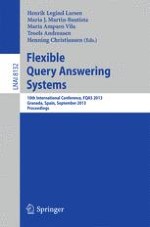This book constitutes the refereed proceedings of the 10th International Conference on Flexible Query Answering Systems, FQAS 2013, held in Granada, Spain, in September 2013. The 59 full papers included in this volume were carefully reviewed and selected from numerous submissions. The papers are organized in a general session train and a parallel special session track. The general session train covers the following topics: querying-answering systems; semantic technology; patterns and classification; personalization and recommender systems; searching and ranking; and Web and human-computer interaction. The special track covers some specific and, typically, newer fields, namely: environmental scanning for strategic early warning; generating linguistic descriptions of data; advances in fuzzy querying and fuzzy databases: theory and applications; fusion and ensemble techniques for online learning on data streams; and intelligent information extraction from texts.
